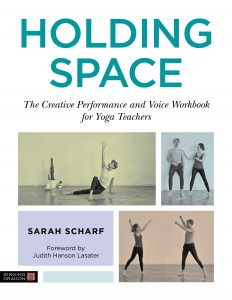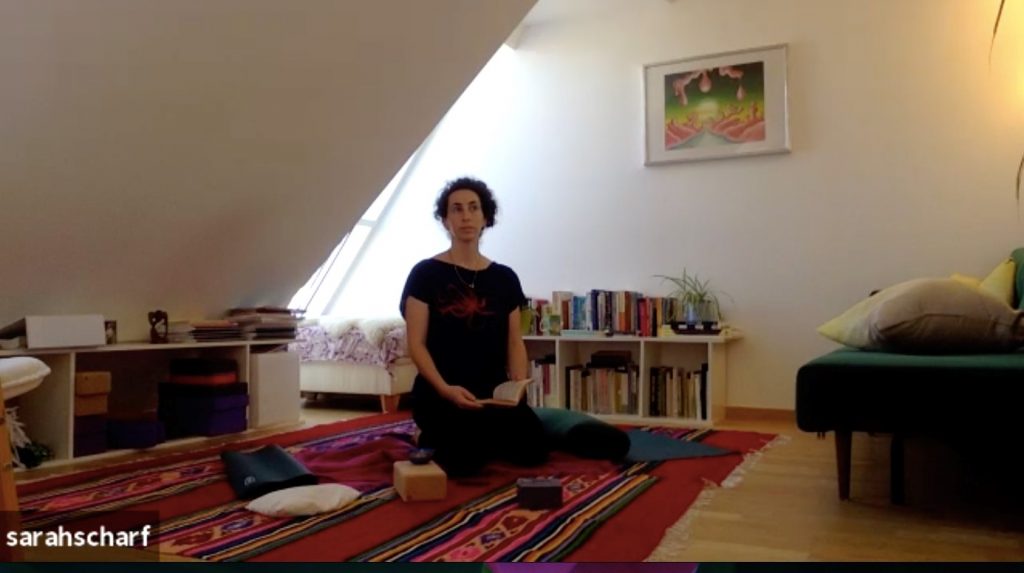 Sarah Scharf, MFA is a yoga teacher, author of the upcoming book, Holding Space: The Creative Performance and Voice Workbook for Yoga Teachers and theatre artist. She holds an MFA in Physical Theatre and has completed multiple training courses in Yoga of various styles. In London she taught at Triyoga – the largest studio in Europe – and worked as a mentor for the Yogacampus Teacher Training. She runs popular workshops and training on voice work and performance skills for yoga teachers, and works as a movement director and teaching artist for theatre. She is an American currently living in Vienna.
Sarah Scharf, MFA is a yoga teacher, author of the upcoming book, Holding Space: The Creative Performance and Voice Workbook for Yoga Teachers and theatre artist. She holds an MFA in Physical Theatre and has completed multiple training courses in Yoga of various styles. In London she taught at Triyoga – the largest studio in Europe – and worked as a mentor for the Yogacampus Teacher Training. She runs popular workshops and training on voice work and performance skills for yoga teachers, and works as a movement director and teaching artist for theatre. She is an American currently living in Vienna.
With the onset of regulations that have temporarily closed yoga studios and suspended public gatherings we have seen a rapid change in the yoga industry. Using live streaming video conferencing has become the most common way of teaching. Many of us have been challenged as teachers not only to learn to use the technology, but also to deal with the emotional elements of growing again as teachers. Some feel like they have to start over, especially those that relied heavily on hands on adjustments during their teaching and didn’t develop the language skills to adequately describe detailed movement or actions. This process of shifting online has shown many of us where we need to grow. It’s an opportunity for us to refine our work, to get more comfortable with ourselves and perhaps even create new opportunities.
There are many ways to teach online. I’ll focus on these options in the context of teaching yoga or movement and meditation:
- interactive livestream classes
- non-interactive livestream classes
- online trainings/workshops/courses
Interactive Live stream
Interactive live stream requires conferencing software if you want to control the entry of participants. The main bonus is that you can see your students in real time. This gives you the opportunity to offer verbal adjustments and individualised instruction. This is only possible when you can see your students, which will require a larger screen for bigger groups so you can avoid scrolling. Some teachers use a projector, making sure it is a quiet one so the sound isn’t a problem. Other teachers avoid demonstrating and simply sit close enough to their screen that they can see everyone.
An option is to sit by the screen and spotlight the video of a dedicated student or assistant who has agreed to be the demonstration model throughout, so that you can focus on watching your students. Another option is of course going back and forth from your mat to demonstrate. Watching the students and giving feedback is very possible through this type of technology. It also offers a chance for students to have a check-in before or after class to provide some time for a community to build. A community is any group of people going through a shared experience or having shared interests. Some students during this crisis are finding their only social interactions are happening before or after class. This opportunity to see other people and connect through the screen has been invaluable to the mental health of many of my students. Having a group conversation on this kind of software requires us to wait until one person is done speaking before we begin. I like the slowing down of conversation and the way it invites us to truly listen for the pause in which to express our thoughts. It reminds me of the theatre warm up where a group must count to 20 with only one person speaking at a time, any interruption or double talk sends you back to number one. This is a great game to play with if you are having a longer discussion online, helping to break the ice and allow everyone to adjust to this form of interacting.
If you are concerned about creating an overly-social atmosphere I suggest having clear boundaries in how you set up the class, perhaps stating on your website or email with the link that you are opening the meeting for a set amount of time before and/or after the class. It’s important to have a FAQs memo for those joining on how to deal with logging in and audio/video. This is also where you can explain why to have cameras on and to let people know that it’s normal for family to walk through the room or pets- basically to assure your students that real life is fine during the session. With all of us in our own homes and those spaces on display there is a more casual and possibly more intimate connection possible. Staying professional is still vital, however the lack of neutral space has the benefit of bringing a closeness, like a veil being lifted. I’m getting to know my students in a different way by seeing them in their own homes and they also get to know me by seeing my living room and hearing my family. Of course in an ideal world we would have actual yoga props and more privacy from others in the house during practice, but the pandemic is teaching us to adapt and be ever more creative. I am finding this to be a beautiful though sometimes painful transformation for the art of teaching. I also think that students who may struggle to have a home practice and depended on the environment of the yoga studio to create their practice space have an opportunity now to make yoga a part of daily life.
When the class officially begins make sure to turn the participants on mute so the sound quality of your microphone is better and there is less feedback or interference from the other microphones. Staying sensitive to those in the group who don’t want to share during a check-in or aren’t comfortable having their camera on is part of creating an inclusive yoga room, even a virtual one.

Non-Interactive Live stream
This is most commonly done via social media, using IGTV, Youtube or Facebook you can “go live” and reach an audience for almost any length of time. You can’t see your students, there are often lots of comments popping up in the bottom of the screen so if you are trying to actually teach anything have your screen where it won’t pull your focus. This platform is good for teaching a practice that you or someone else demonstrates throughout, with a fixed camera the entire time. It most often used for donation-based or free content. The free content is usually either being compensated through advertising or the content itself is an advertisement for something more that will have a price. One more issue with these live platforms is that the anonymity of social media invites people to drop in and out, they might just pop over and look for a moment at what you are doing rather than actually practice or learn. Facebook gives you the option to archive a live post, however Instagram only offers the live recording on your story for 24 hours. I wouldn’t use this platform for anything of deeper educational content.
Online Trainings/Workshops/Courses
This form of education has been around for years, however with all yoga teacher trainings suspended at the moment it is becoming more popular and the Yoga Alliance has temporarily accepted 200 and 300 hour trainings done online. At the moment there are a lot of online trainings on how to make an online training! If you have a subject you want to cover more thoroughly and create a stream of income that does not require your time in the present moment than this format is worth investing in. There are websites like Thinkific or Udemy that provide you with the tools to create the material online and make it look professional as well as giving you another place to advertise and find an audience. Yoga sites like YogaUonline, Yogacampus, Yoga Journal and Yoga International for example all offer different forms of online learning. There is a lot of creativity possible in this type of work, from scheduled live calls or webinars or forums for students to interact with you or with each other, to creating social media groups for each course. When planning a course the best advice I have heard so far is to be clear about exactly what you want to teach, and work backwards to create the lessons and curriculum to support the educational journey of your students. As most of us would never have imagined teaching a yoga class in person before experiencing any ourselves I think it is important to try different types of online learning to help you decide what you like, what supports your style of teaching and your content. There is so much to learn from noticing what you do and what you don’t enjoy about these options.
Recordings of Live stream Classes
Always check with privacy issues related to sharing any content that includes images of your students. I’m not a fan of seeing pictures where students are being used to market something and they are clearly just there to do a class. If you want to use any image that includes a student, for social media or your website or for educational purposes you must get their written permission.
An easy way to build up your online offerings or compile something into a course is to use either video or audio from the live classes. Test out your recording equipment and start! You can offer these recordings as a passive stream of income.